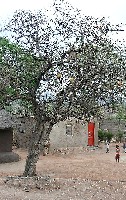View crop
View crop Data sheet EcoPortStrychnos spinosa
 |
|
| Notes |
|---|
| DESCRIPTION: It is a thorny shrub or small tree 1-9 m in height. Fruit spherical, woody shelled, 5-12 cm in diameter, deep yellow to yellow-brown when mature, contains many flat seeds. USE: The sweet-sour fruit pulp is edible but the seeds and unripe fruit are toxic. Leaves are also eaten and used as fodder. Wood is used as timber and firewood and charcoal. Juice from the fruit and roots is dropped into the ears as a remedy for earache; the roots, leaves and bark are used in the treatment of disorders of the male organs. A decoction of the roots is taken orally for colds or is drunk with milk to cure dropsy. Roots or green fruits are used by the Zulu of South Africa as an antidote for snakebite. The roots alone provide an emetic and also a remedy for fever and inflamed eyes. An analgesic is made from a decoction of the leaves. Jigger fleas are removed from the feet after applying a paste in which the grated root is mixed with oil. Oil extracted from the root is applied to the skin as a fly repellent. GROWING PERIOD: Perennial. COMMON NAMES: elephant orange, monkey ball, monkey orange, natal orange, spiny monkey ball. FURTHER INF: Occurs in savannah forests all over tropical Africa and grows in open woodland and sandy riverine fringes. | Sources |
| SOURCE: ICRAF Agroforestree Database (09.07.02) E10135 |